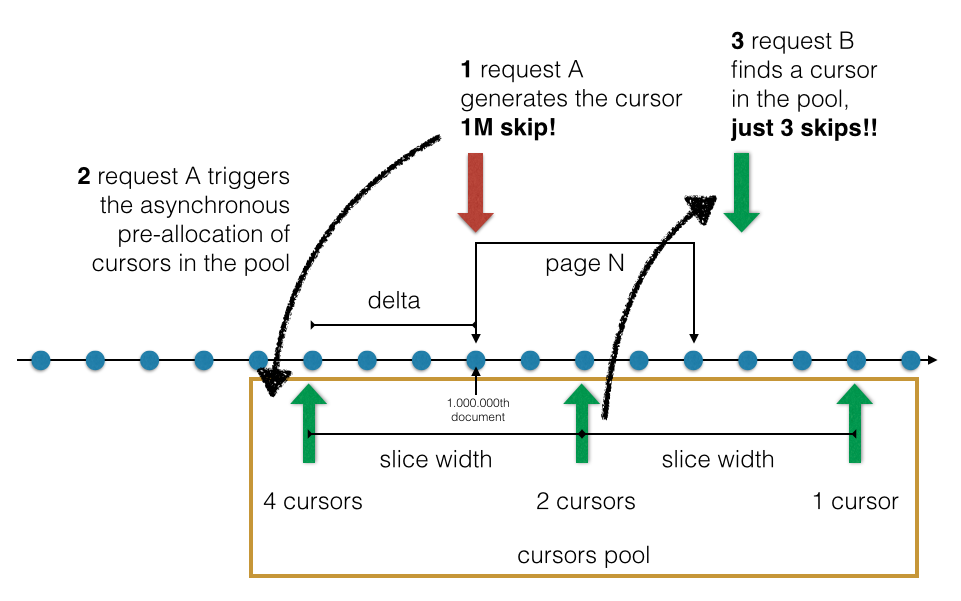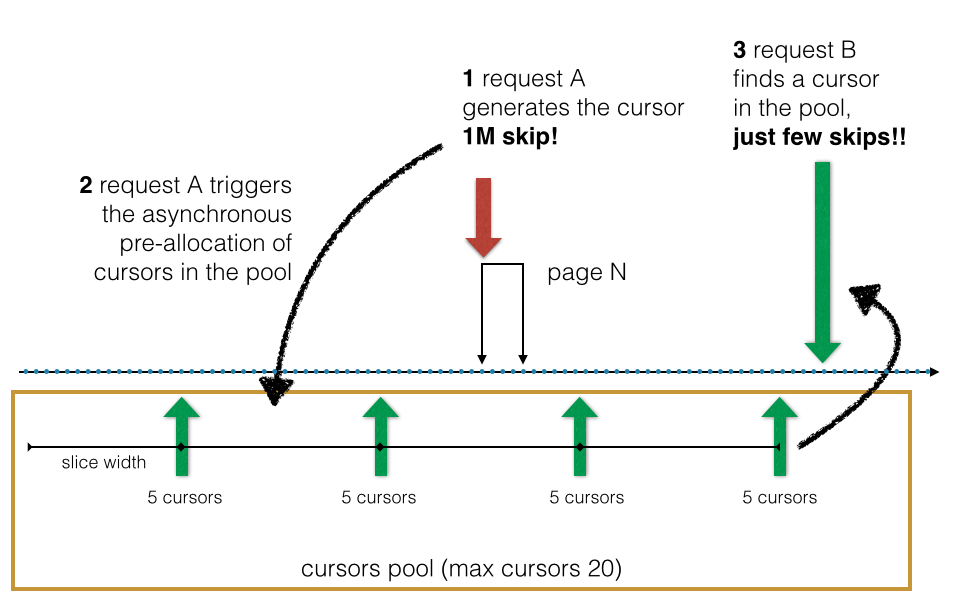Speedup Requests with Cursor Pools
Introduction
RESTHeart speedups the execution of GET requests to collections resources via its db cursors pre-allocation engine.
This applies when several documents need to be read from a big collection and moderates the effects of the MongoDB cursor.skip() method that slows downs linearly.
In common scenarios, RESTHeart’s db cursor pre-allocation engine allows to deliver brilliant performances, even up to a 1000% increase over querying MongoDB directly with its Java driver.
Refer to the Performances section for more information and real case results.
Let’s first clarify the issue addressed by the engine.
RESTHeart allows to query documents via GET requests on collection resources where documents are returned as embedded resources.
$ http -a a:a GET "127.0.0.1:8080/test/coll?count&page=3&pagesize=10"
HTTP/1.1 200 OK
...
{
"_embedded": [
{ <DOC30> }, { <DOC31> }, ... { <DOC39> }
],
...
}
Of course documents are returned as paginated result sets, i.e. each request returns a limited number of documents.
Pagination is controlled via the following query parameters:
page: the range of documents to returnpagesize: the number of documents to return (default value is 100, maximum is 1000).
Behind the scene, this is implemented via the MongoDB cursor.skip() method;
The issue is that MongoDB queries with a large “skip” slow down linearly. As the MongoDB manual says:
The cursor.skip() method is often expensive because it requires the server to walk from the beginning of the collection or index to get the offset or skip position before beginning to return result. As offset (e.g. pageNumber above) increases, cursor.skip() will become slower and more CPU intensive. With larger collections, cursor.skip() may become IO bound.
That is why the MongoDB documentation section about skips suggests:
Consider using range-based pagination for these kinds of tasks. That is, query for a range of objects, using logic within the application to determine the pagination rather than the database itself. This approach features better index utilization, if you do not need to easily jump to a specific page.
How it works
When RESTHeart detects a query involving many skips (with a big page query parameter), in parallel it starts pre-allocating other cursors (with same sort, filter and projection parameters) in a pool; further similar requests will be served much quicker because the cursors needed to retrieve the data will probably be in the pool and already skipped.
- Requests involving less skips than eager-cursor-allocation-linear-slice-width parameter value, will not trigger the pre-allocation of cursors.
- A request involving to skip N documents will use a cursor from the pool only if it has been skipped by more than 90% of N documents (tests suggests this to be the case).
- Cursors will last in the pool for 8 minutes (MongoDB will timeout the cursors in 10 minutes anyway).
- Two different cursors allocation policies can be applied and controlled by the eager query parameter: LINEAR and RANDOM. The former will better improve a linear scanning of the collection (reading pages in sequence), the latter, random accesses.
The difference between the two policies is that in the LINEAR case, a configurable number of cursors are allocated near the original request, following the principle of locality; in the RANDOM case, a configurable number of cursors is allocated uniformly.
The following images depicts how it works, in the LINEAR case:** **
- Request A asks for 5 documents starting from the 1.000.000th document. MongoDB needs to generate a cursor skipping 1.000.000 documents: this takes time to complete;
- Asynchronously, the db cursor pre-allocation engine creates few cursor in the pool (delta, slice width and actual number of cursors being configurable);
- Request B asks for 5 documents starting for the next page. RESTHeart finds cursor in the pool that has been already skipped. In this case, only 3 more skips are needed.

The following images depicts how it works, in the RANDOM case:
- Request A asks for 5 documents starting from the 1.000.000th document (page=200.000). MongoDB needs to generate a cursor skipping 1.000.000 documents that takes time to complete;
- Asynchronously, the db cursor pre-allocation engine creates few cursor in the pool (slice width and actual number of cursors being configurable)
- Request B asks for the 250.000th page. RESTHeart finds a cursor in the pool that has been already skipped. In the worst case only slice width skips are needed.

Request parameters
The engine is controlled by the eager query parameter. Possible values are:
value
|
description
|
default
|
|---|---|---|
linear |
LINEAR policy | √ |
random |
allocate cursors RANDOM policy | |
none |
the cursor pool will not be used |
Example
$ http -a a:a GET "127.0.0.1:8080/test/coll?count&page=1000&pagesize=1000&eager=random"
Configuration
## eager db cursor preallocation policy
# in big collections, reading a far page involves skipping the db cursor for many documents resulting in a performance bottleneck
# for instance, with default pagesize of 100, a GET with page=50.000 involves 500.000 skips on the db cursor.
# the eager db cursor preallocation engine boosts up performaces (in some use cases, up to 1000%). the following options control its behavior.
eager-cursor-allocation-pool-size: 100
eager-cursor-allocation-linear-slice-width: 1000
eager-cursor-allocation-linear-slice-delta: 100
eager-cursor-allocation-linear-slice-heights: [ 4, 2, 1 ]
eager-cursor-allocation-random-max-cursors: 20
eager-cursor-allocation-random-slice-min-width: 1000
| parameter | description |
|---|---|
|
The maximum number of cursors to allocate overall. Note that a pool is generate for each combination of filter, sort_by and key parameters. |
|
Applies for the LINEAR policy. It is the width of a pool slice, i.e. the distance between two cursors clusters. |
|
Applies for the LINEAR policy. Cursors are not preallocated exactly from the first request page, but Delta skips before. This allows to cover the case when further requests are actually for a previous pages. |
|
Applies for the LINEAR policy. It is the number of clusters to generate and cursors to allocate For instance the value [4,2,1] means to create 3 clusters, the first with 4 cursors, the second with 2 and the last with 1. |
|
Applies for the RANDOM policy. It is the the maximum number of cursors to allocate for each combination of filter, sort_by and key parameters. |
|
Applies for the RANDOM policy. It is the minimum width of a pool slice, i.e. the minimum distance between two cursors clusters. |
Consideration on concurrent insertions
When iterating a cursor that uses an index for the sort, then:
- a document inserted after the cursor’s position will appear in the results.
- a document inserted before the cursor’s position doesn’t affect the cursor’s position or meaning of the current “skip”.
When iterating a sorted cursor without an index, documents inserted after the cursor will not appear in the results. Note that, if the collection is big, sorting by properties that are not indexed is not a good idea and will probably lead to a MongoDB error anyway.
In this case, the eager=none parameter can be specified.